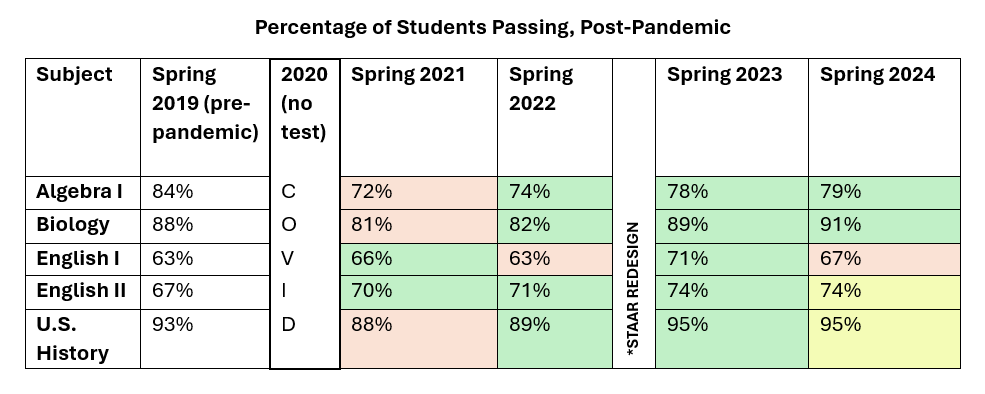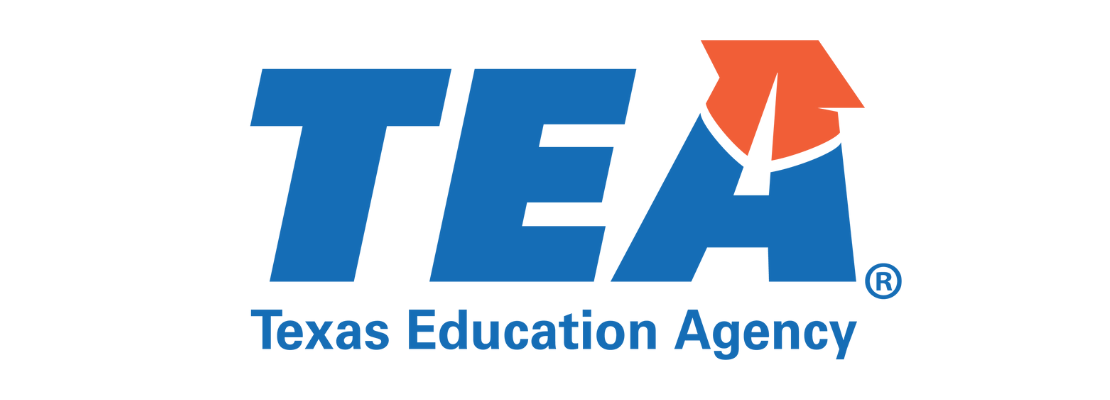TEA’s STAAR Press Release Doesn’t Tell the Whole Story

Date Posted: 6/12/2024 | Author: Tricia Cave
The Texas Education Agency (TEA) released spring 2024 STAAR End of Course (EOC) assessment data June 7. EOC assessments are done in high school and include Algebra I, Biology, English I, English II, and U.S. History. Parents can view their child’s scores here. You must have your child’s unique access code to view their scores.
TEA’s press release touted a 4% increase in English II scores, while U.S. History, the agency said, had a 2% decrease. English I, Algebra I, and Biology all held steady, according to the agency. Emergent Bilingual (EB) students showed increases across all EOC assessments.
In the release statement, TEA Commissioner Mike Morath said: “The 2024 STAAR End-of-Course results highlight both the progress Texas students and educators have made and the challenges that remain to help students improve outcomes, which can only come from a robust assessment and accountability system. While we celebrate the gains in English II, we must also acknowledge the areas where student performance has not recovered to pre-pandemic levels.”
When parsing accountability scores, it’s helpful to have a history of Texas’ system for labeling outcomes on state standardized tests. Initially, individual students’ scores were deemed either passing or failing. Student scores were then rolled up into campus and district ratings: unacceptable, acceptable, recognized, and exemplary. Within the accountability system, an individual student with a rating of “acceptable” or higher was deemed to have passed. These labels were replaced with A-F letter grades, with the passing line set between D/F and C. After campus and district labels were changed, students also received a new set of student level accountability labels: masters, meets, approaches, and does not meet. A student with a rating of “approaches” or higher was deemed to have passed.
TEA’s press release relies on the higher “meets” standard vs. the actual passing standard. Although TEA’s language is not technically false, it could well leave the impression that an entire cohort of students had not passed the STAAR when they actually did. When you take all students who passed into account, the picture is very different in relation to growth in STAAR EOC scores in the post-pandemic era. Overall, this TEA data shows that high school performance has continued to hold steady or increase since the pandemic, with only English I scores going down in 2022 and 2024, respectively. As a former U.S. History teacher, I also want to point out that a 95% student passage rate is incredible and leaves little room for growth, though I know teachers will continue to push and improve.

Source: Texas Education Agency
It is also important to note that during the 2022-23 school year, the STAAR test was redesigned in order to comply with House Bill (HB) 3906 by former Public Education Chairman Dan Huberty from the 86th Legislature. The test was made more difficult via new question types and a cap on the number of multiple-choice questions, which the agency said would “better reflect classroom instruction.” The new question types include short answer, hot spot, number lines, inline choice, drag and drop, and short and long constructed response. Additionally, cross-curricular passages were added to reading and language arts tests, and the type of writing sample collected and graded for students shifted from prompt-based to evidence-based response. Despite the challenges of a more difficult test and the move to a digital test format, every EOC—with the exception of Algebra I—is currently at a higher passing rate than pre-COVID, with Algebra I on track to reach that mark in the next year or two.
We should not, of course, dismiss the data that shows “meets grade level” and “masters.” These are benchmarks that can be used to continue to push ourselves as educators and students. We should, however, acknowledge that “grade level” is itself a somewhat arbitrary standard. It doesn’t reference a student’s cognitive development at a particular age, which varies greatly from student to student and rarely follows a tidy linear path. In Texas, it’s a reference to the TEKS, skills we have bundled together by grade for convenience, which have been changed—sometimes dramatically—many times over the years. Accountability numbers are often presented as though they are related to a scale that has remained static when in fact the test has been redesigned, the goal posts have shifted several times as benchmarks have been changed since the STAAR EOC exams were introduced more than a decade ago, and the underlying expectations defining "grade level" have changed as the rigor of the TEKS has increased over the years. Notably, most parents do not know what each of these standards mean, how they relate to one another, and what score their student must reach to attain them. If we are going to measure students with an arbitrary, constantly shifting standard, TEA must do a better job of educating all stakeholders about the implication of each standard level, how changes in either the TEKS or test impact the standard, and how educators can use the data to further student academic growth.
Given the challenging circumstances of declining attendance, test redesign, and pandemic recovery, it is actually quite remarkable our students have continued to grow and achieve. While there is certainly work to do, Texas teachers and students continue to rise to the occasion and have much to be proud of.
CONVERSATION
RECOMMENDED FOR YOU

12/19/2025
Teach the Vote’s Week in Review: Dec. 19, 2025
Happy Holidays from ATPE! The ACLU of Texas is challenging SB 12 in federal court, and ATPE has distributed candidate surveys to those running for statewide, legislative, and SBOE seats.

12/18/2025
Gov. Abbott’s property tax promise and the split in the Texas GOP
Property taxes aren’t just a political talking point. They’re the main revenue source for vital local services, including police, fire, and public education.

12/12/2025
Dec. 8 filing deadline sets the stage for 2026 elections
Now’s the time to confirm your voter registration and update it if necessary.


The funny thing is from year to year you aren’t really comparing apples to apples. 2023 and 2024 could be compared to one another because they were both online and they were the same kind of questions. I have been teaching in elementary since the different changes have occurred. I’m a dyslexia specialist at the majority of my students are at least at the approaching level in Math and ELA. With a test like this, I’m proud of my students because they don’t have standardized minds and tests of this magnitude don’t truly show what they know and can do on a daily basis.
Please also to consider that TEA sets that passing rate each year- for US History, for example, the cut scores between 2022 and 2023 dropped drastically. Approaches was set at 40% in 2022 and dropped to 28% in 2023 & 2024. Source: https://tea.texas.gov/student-assessment/testing/student-assessment-results/raw-score-conversion-tables